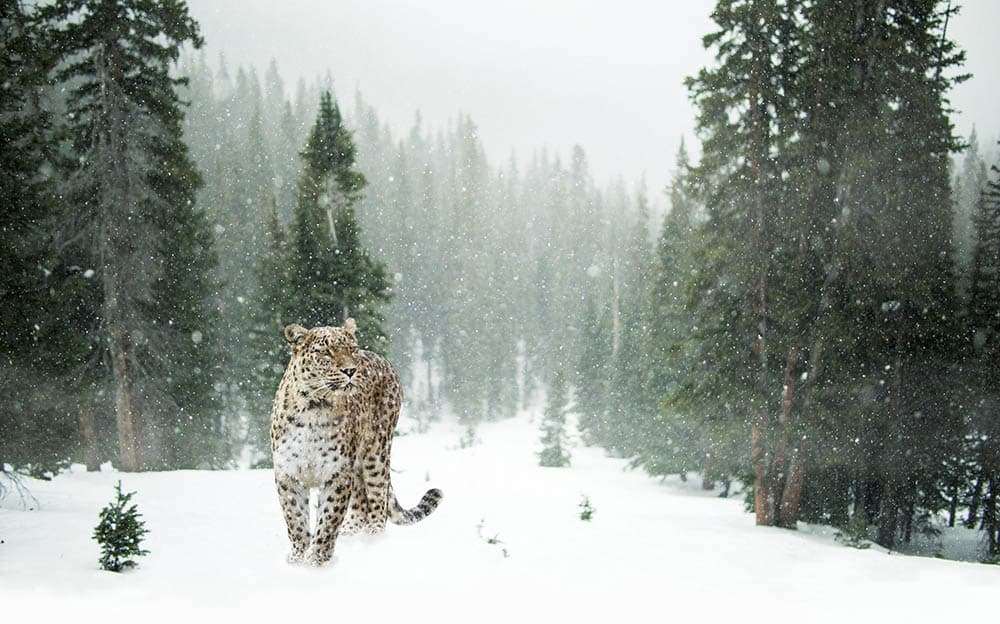A total of 15 different species of wild cats live on the Indian subcontinent—a number unmatched anywhere else in the world. These apex predators are incredibly important to the biosphere, and they play a crucial role in the food chain. The extinction of any one of these predator species could have a significant impact on nature’s balance.
Unfortunately, many of these cats are endangered, and their populations are in decline. Wildlife conservationists are working hard to protect these animals, but it is a difficult task. In recent years, there has been a concerted effort to protect these creatures, through conservation programs and education initiatives. This article will count down the 15 most common wild cats in India, using the International Union for Conservation of Nature Red List of Threatened Species (IUCN Red List) to go from least concern to the most endangered wild cats.

Least Concern
This is a diverse group, comprising five wild cat species that range in size from the small Leopard Cat to the medium-sized Caracal. Cats from this group are among the most common in the country. These wild cats can be found in a variety of habitats, from dense forests to dry scrublands. While they thrive in different areas, they all prefer to inhabit places that offer plenty of cover and prey.
1. Asiatic Wildcat
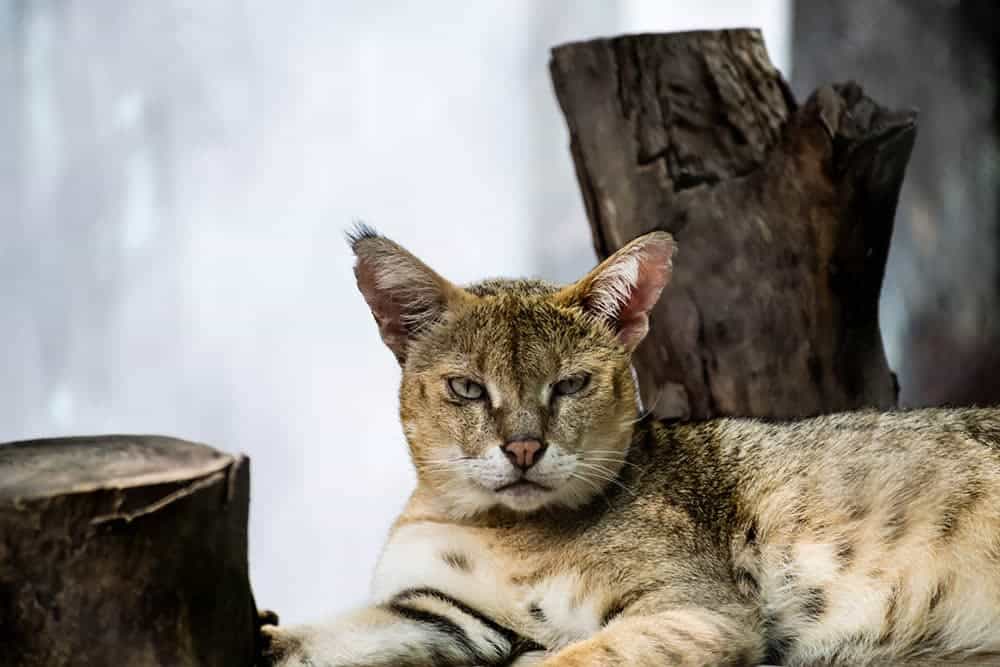
| Latin name: | Felis lybica ornata |
Although the Asiatic Wildcat is an African wild cat subspecies, they have made their homes across a vast territory—from the eastern Caspian Sea, through Kazakhstan, and into western India, western China, and even southern Mongolia. Also known as the Asian Steppe Wildcat and Indian Desert cat, their habitats include low-lying deserts, scrub deserts, and semideserts. Asiatic Wildcats are opportunistic carnivores and feed on a variety of animals, including birds, hares, insects, lizards, red-tailed gerbils, and voles.
The Asian Wildcat is a solitary animal but can be seen frequently during the day. There are several types of Asiatic Wildcat, but in India, they tend to have pale sandy or yellow coats, which are speckled down their bodies and sides with brown spots that run vertically.
2. Caracal
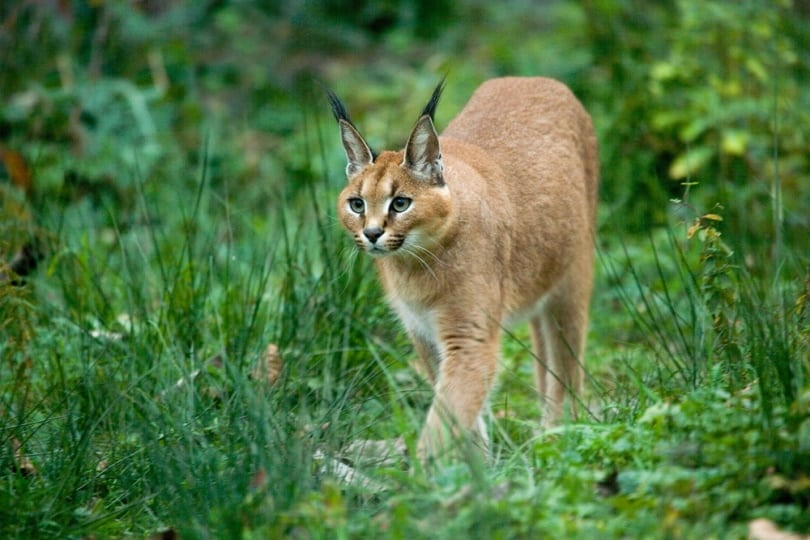
| Latin name: | Caracal caracal |
This medium-sized wild cat lives in Africa, the Middle East, Central Asia, and arid areas of Pakistan and northwest India. They are reddish-tan with lighter-colored bellies and have slender legs, short faces, elongated canine teeth, and characteristic long, tufted ears. Caracals are typically nocturnal and difficult to observe. The species is territorial, and it usually lives alone or in pairs. Caracals are carnivorous mammals that prey on small mammals, birds, and rodents.
This species is athletic and can leap up to a height of 3 meters (10 ft) and catch birds in midair. Forests, savannas, marshes, semideserts, and scrub forests are among their habitats, but low-rainfall areas with good cover are their favorite.
3. Eurasian Lynx
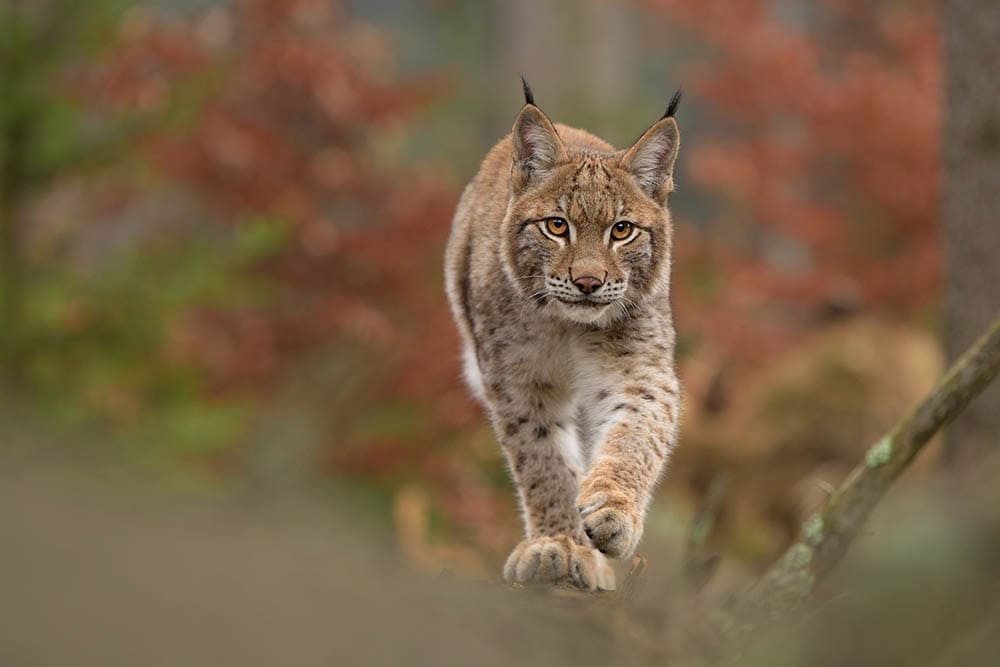
| Latin name: | Lynx lynx |
A medium-sized wild cat, the Eurasian Lynx is found across a vast swathe of land running from northern and central Europe, through Central Asia, to Siberia and the Tibetan Plateau and Himalayas. Eurasian lynxes live in rugged terrain that provides plenty of hiding spots and stalking opportunities, typically at high elevations. These cats have relatively short, reddish or brown coats marked with black spots; the number and pattern of the spots are highly variable, with whitish underparts, neck, and chin.
Their large webbed paws act like snowshoes, at the end of powerful, relatively long legs, their tail is short and bobbed with an all-black tip, and their pointed ears have black tufted tips.
4. Jungle Cat
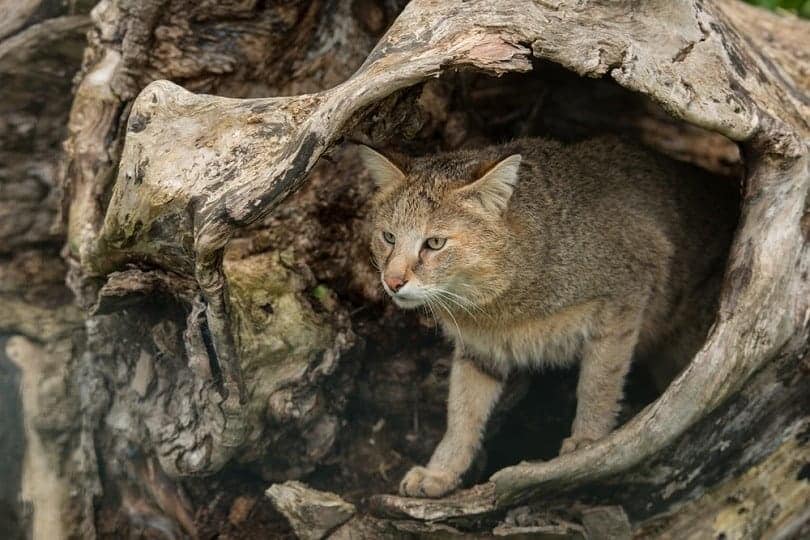
| Latin name: | Felis chaus |
Jungle Cats, also known as Reed Cats and Swamp Cats, are medium-sized cats native to the Middle East, Black Sea, India, Southeast Asia, and China’s southern provinces. Swamps, wetlands, and riverine areas with abundant vegetation are its primary habitats. The Jungle Cat’s fur is uniformly sandy, reddish-brown, or gray. As a species, they are generally solitary, except for during the mating season and during the mother-kitten period.
In order to maintain their territories, adults spray urine and mark their territory with scent. Hunting involves stalking, sprinting, or leaping; their large ears assist in pinpointing the location of prey. Birds and small mammals are their preferred food sources.
5. Leopard Cat
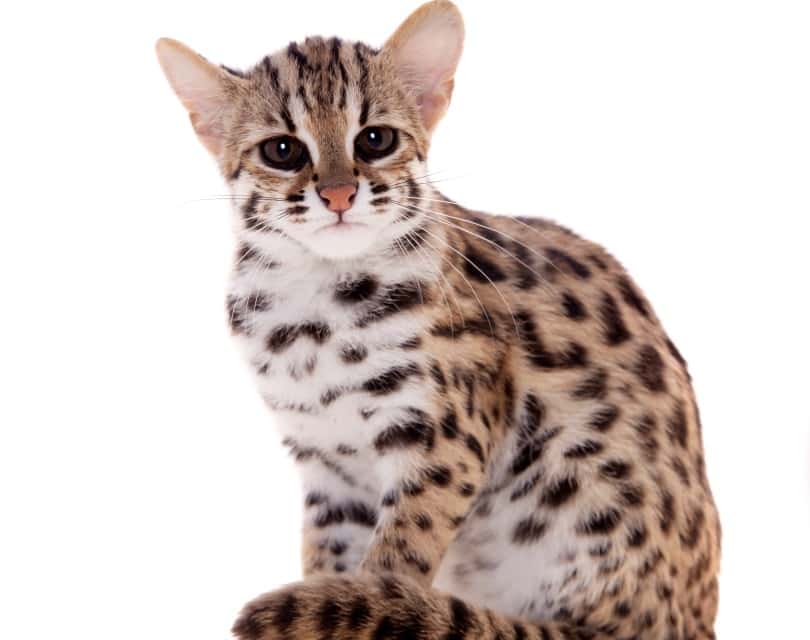
| Latin name: | Prionailurus bengalensis |
Leopard cats are small wild cats native to Southeast Asia, East Asia, and India. About 5,000 years ago, the Leopard cat became the first domesticated cat in the Shaanxi and Henan Provinces of China. Leopard cats are about the size of domestic cats, but they are slender, have longer legs, and have well-defined webs between their toes. Southern populations have spotted, yellowish-brown fur with a white chest, belly, and muzzle.
Regional populations differ so much in coloration, size, and weight that initially they were thought to be several species. Except during breeding season, leopard cats live solitary lives. While some are active during the day, most hunt at night, preferring rodents and hares for prey. They’re agile climbers and quite comfortable in the trees, although they also hide in dense undergrowth on the ground.
6. Pallas’s Cat
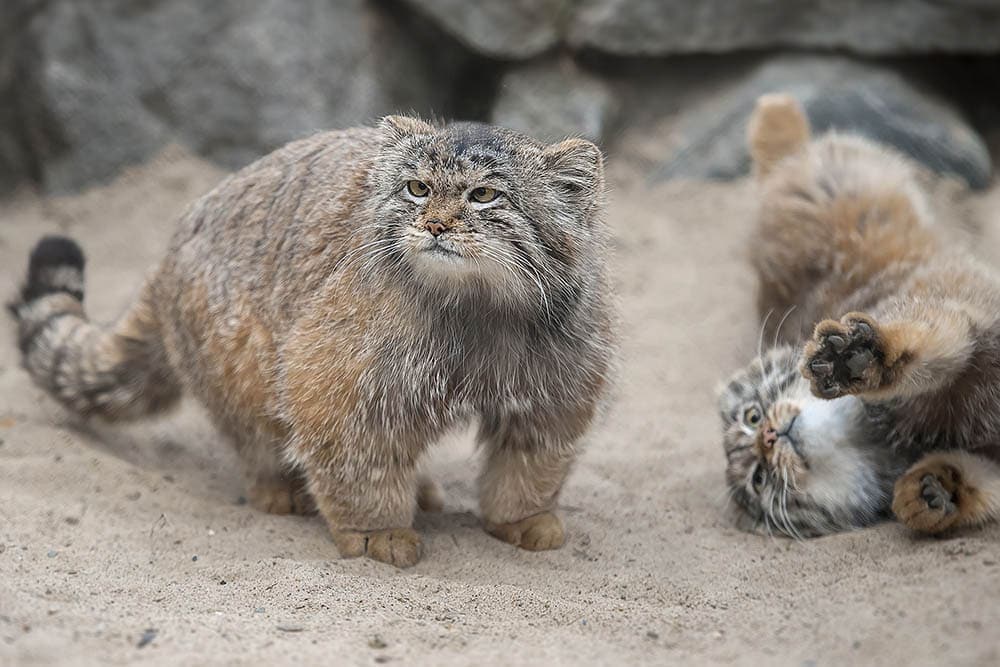
| Latin name: | Otocolobus manul |
The Pallas’s cat, also known as the manul, is a small, grey wildcat with long, dense fur. From the Caucasus eastward, it ranges into Central Asia, Mongolia, Northern India, and the Tibetan Plateau. Usually found in mountain shrublands, grasslands, and rocky outcrops where there is only shallow snow cover. Adapted to its native range, it is well camouflaged. Unlike other small cats, the Pallas’s cat has rounded pupils rather than vertical slits.
Pallas’s cats are solitary using caves, rock crevices, and other mammals’ burrows for shelter. As a highly specialized predator, Pallas’s cats stalk or ambush small mammals near burrow entrances to catch them.

Near Threatened
These wild cats of India are near threatened due to a variety of factors including habitat loss and fragmentation, hunting, and poaching. These threats have caused the populations of these cat species in India to decline. In order to protect these animals, it is important to raise awareness about the threats they face and to create and implement conservation measures that will help ensure their survival.
7. Asiatic Golden Cat
| Latin name: | Catopuma temmincki |
Asian Golden cats are medium-sized wildcats native to northeastern India, Southeast Asia, and China. Since 2008, it has been listed as Near Threatened on the IUCN Red List and is threatened by poaching and habitat destruction. Asian Golden cats come in a variety of colors. In northeastern India, golden, reddish brown, and buff-brown cats have been recorded. They are territorial and solitary, and while they are typically nocturnal, they have been observed active during the day in northeast India at around noon.
When necessary, Asian Golden cats can climb trees. They hunt birds, reptiles, small deer, and other small mammals. Their ability to bring down larger prey, such as water buffalo calves, is quite impressive.
8. Marbled Cat
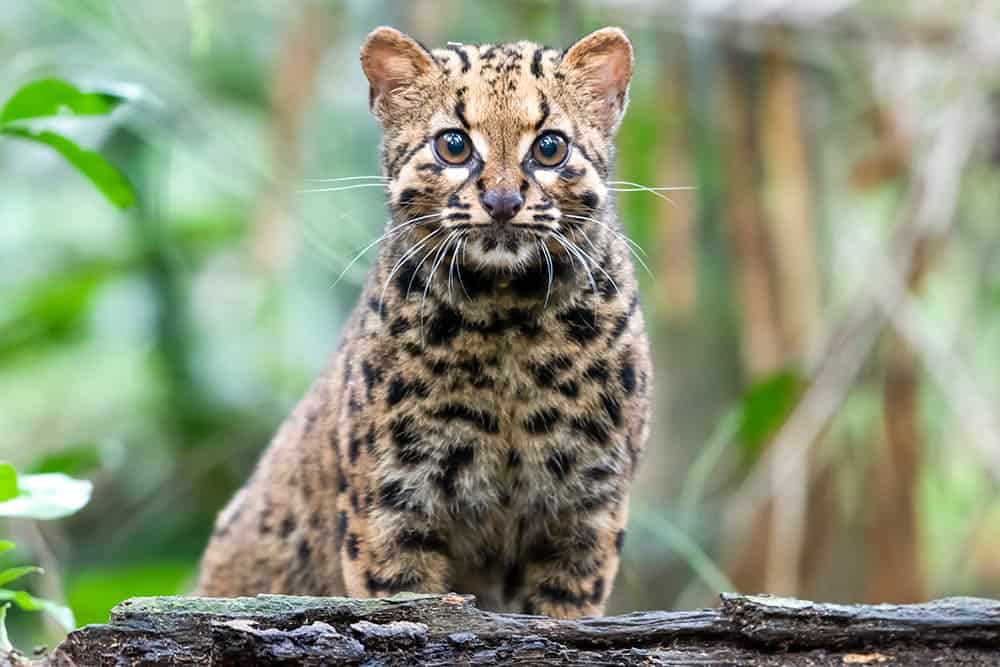
| Latin name: | Pardofelis marmorata |
The Marbled cat inhabits forests up to an elevation of 2,500 meters in the eastern Himalayas and Southeast Asia. Marbled cats are similar in size to domestic cats, but have very long tails that are as long as their heads and bodies. Its long fur varies in color from brownish-grey to ochre. The head and body are patterned with black stripes. Solid spots cover the tail, limbs, and underbelly. The paws are completely covered and webbed between the digits. It has a thick, soft coat. Like big cats, it has large feet and unusually large canine teeth.
Marbled cats probably hunt birds, squirrels, and other rodents and reptiles in forest canopies.
9. Rusty-spotted Cat
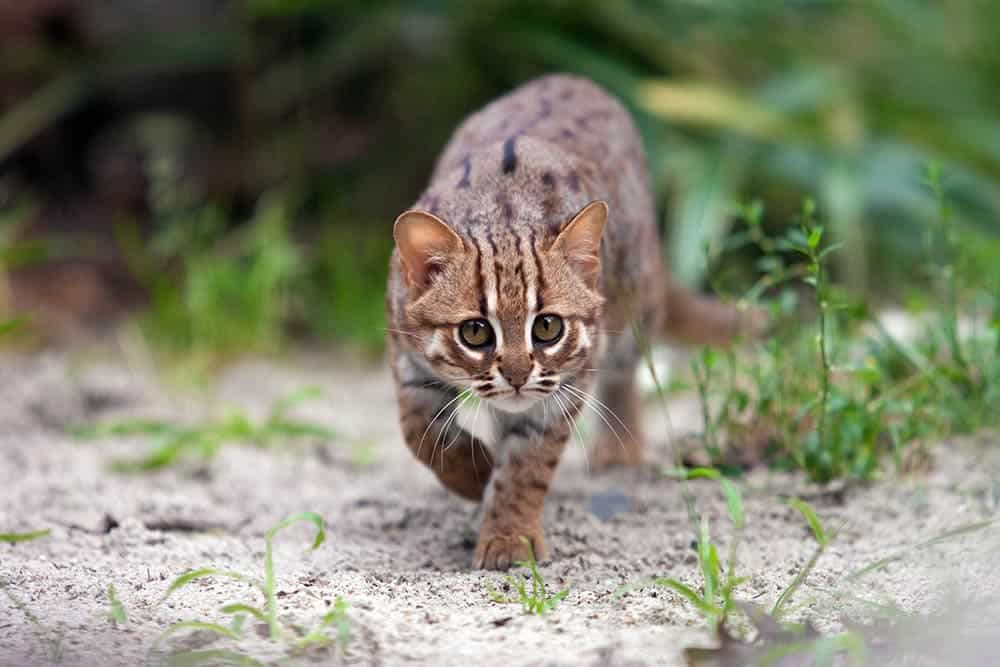
| Latin name: | Prionailurus rubiginosus |
The Rusty-spotted cat is one of the smallest cats in the world, and Asia’s smallest wild cat. It can be found throughout much of India, despite long-standing beliefs that it could only be found in the south. This cat’s body is reddish gray with rusty spots all over. The eyes have four blackish lines, and two of them extend over the neck. The chin, throat, inner side of limbs, belly, and chest are all whitish with brownish spots. The paws and tail are uniformly reddish gray. Mostly found in deciduous forests, scrub, and grassland, the rusty-spotted cat is rarely seen in evergreen forests.
Aside from rodents and birds, it also preys on lizards, frogs, and insects. Mostly a ground hunter, it makes rapid, darting movements to catch prey.

Vulnerable
The Clouded Leopard, Fishing Cat, Leopard, and Snow Leopard are considered vulnerable wild cats in India. This means that they are at risk of becoming endangered in the near future if their populations continue to decline. One of the main threats to their survival is habitat loss due to deforestation and development. These cats are also hunted for their fur, and their prey is threatened by poaching and human-wildlife conflict.
10. Clouded Leopard
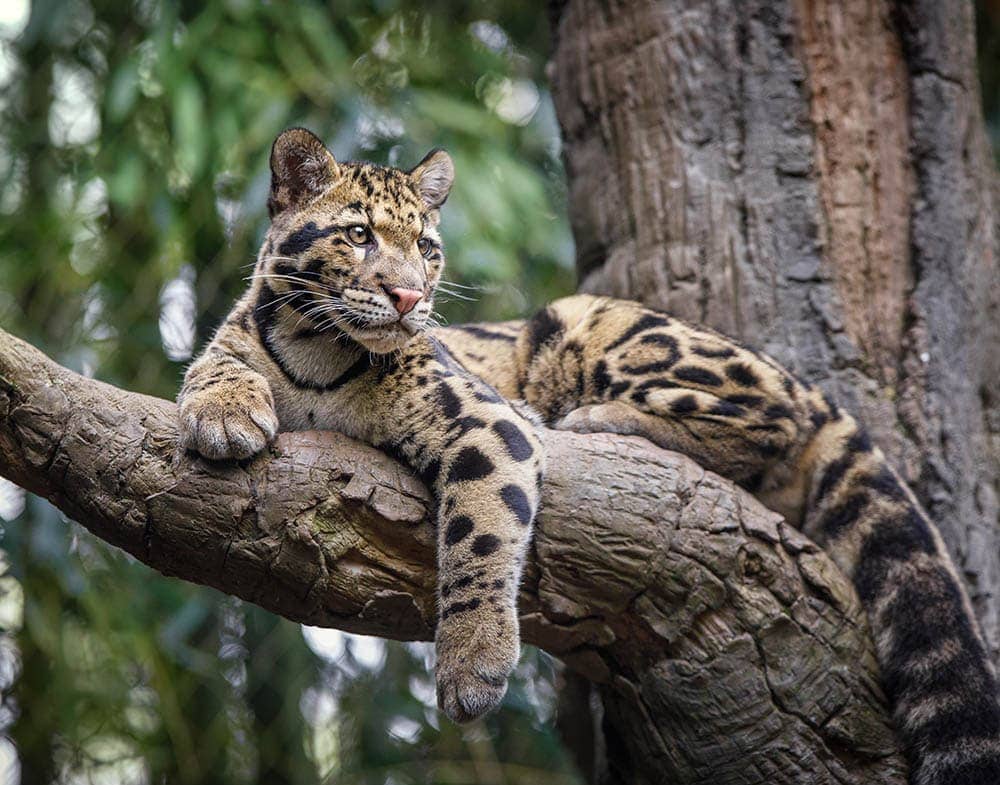
| Latin name: | Neofelis nebulosa |
Clouded Leopards live in dense forests from the foothills of the Himalayas through mainland Southeast Asia and South China. Large clouds-like blotches cover its body, along with irregular spots and stripes. During the day, it rests in trees, and at night, it hunts on the forest floor. Among cats, Clouded Leopards are some of the best climbers. As they move in trees, they use their tails to balance and are able to descend vertical trunks headfirst.
While they are legally protected in most countries where they are found, the trade in their body parts, which are used for decoration and clothing, is still strong. As a result, Cloud Leopards have a declining population trend. As a result, they have been listed as Vulnerable on the IUCN Red List since 2008.
11. Fishing Cat
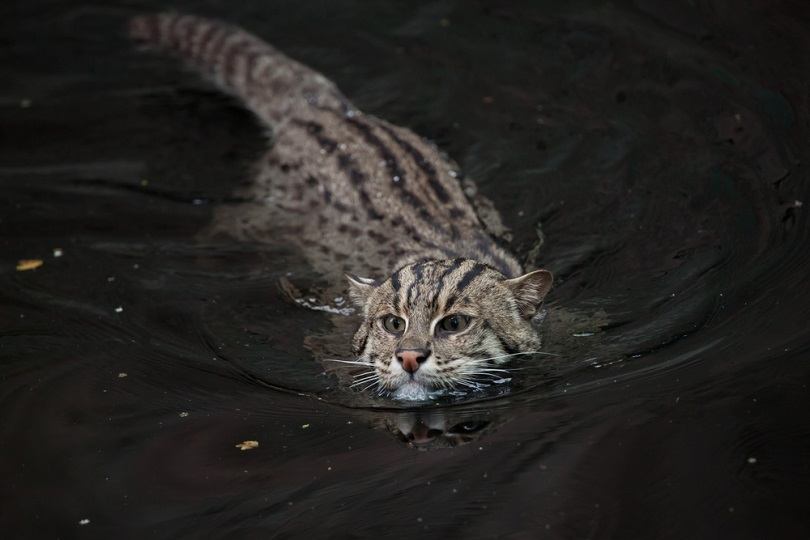
| Latin name: | Prionailurus viverrinus |
Fishing Cats are medium-sized wild cats found in South and Southeast Asia. Most Fishing Cats live in wetlands, rivers, streams, swamps, and mangroves. Fishing Cats have yellowish-grey fur with black lines and spots. Tails are short, less than half the length of the head and body, and ears are short and rounded. Due to its aquatic adaptation, the Fishing Cat’s fur is layered, with short, dense fur providing a water barrier and insulation with longer guard hairs over the top. With medium to short legs, they are about twice the size of a domestic cat.
Fishing Cats are nocturnal and love water. Even underwater, they swim long distances. About three-quarters of a Fishing Cat’s diet consists of fish, with the remainder consisting of birds, insects, and small rodents. During the past decade, Fishing Cat populations have plummeted due to wetlands destruction.
12. Leopard
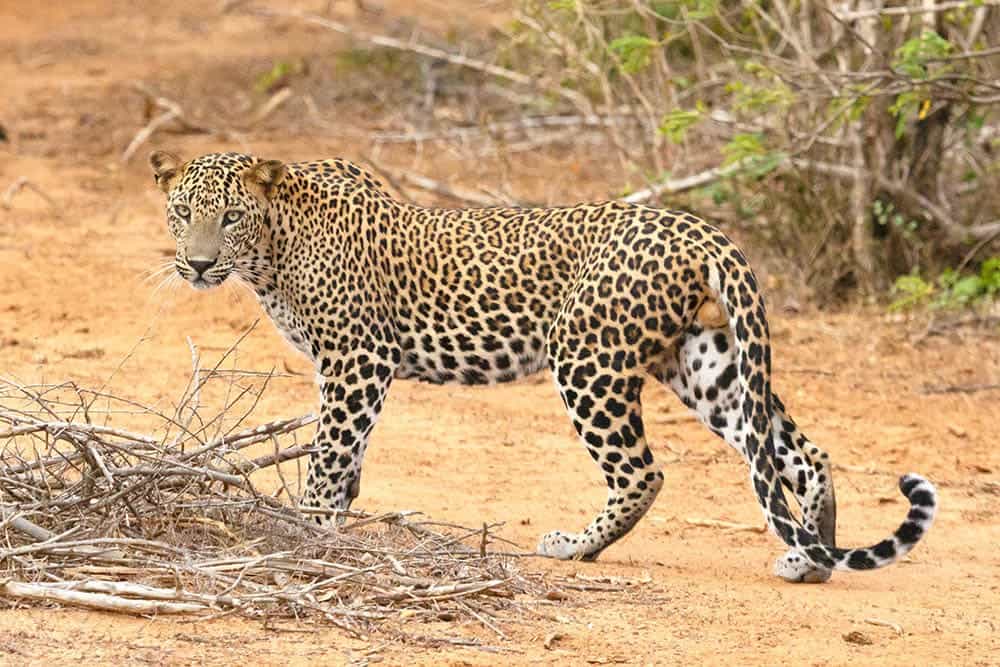
| Latin name: | Panthera pardus |
A Leopard’s range of habitats includes sub-Saharan Africa, Western and Central Asia, Southern Russia, the Indian subcontinent, and Southeast and East Asia. IUCN classified leopard populations as vulnerable due to habitat loss and the decline of their global range. Leopards have relatively short legs and a long body with a large skull when compared to other wild cats. Although it has a similar appearance to the jaguar, the Leopard’s spotted rosettes are generally smaller and less densely packed.
Leopards have highly camouflaged fur, an opportunistic hunting style, a diverse diet, strength, and power, and are able to adapt to a variety of habitats including jungles, grasslands, deserts, and mountain areas. All this and speed—they are formidable hunters that can run at a top speed of 58 km/h (36 mph).
13. Snow Leopard
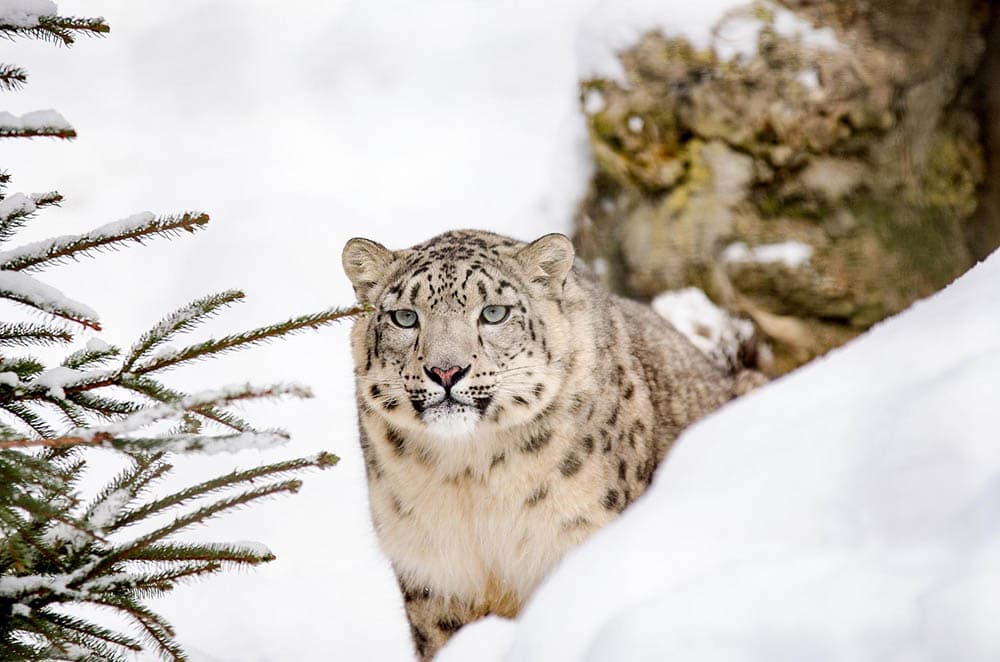
| Latin name: | Panthera uncia |
This wild cat is native to mountain ranges throughout Central and South Asia, including India. It is listed as vulnerable on the IUCN Red List due to its declining global population. Snow Leopards have whitish to gray fur with black spots on their heads and necks, and large rosettes on their backs, flanks, and tails. They have stocky bodies and short legs. A solitary animal, they are active mostly from dawn until early morning, and again in the afternoon and early evening. Cliffs and ridges provide vantage points and shade for this active carnivore.
In pursuit of prey, using the momentum of their initial leap, Snow Leopards chase large mammals including goats, sheep, deer, and boar down steep mountainside slopes for up to 300 meters (980 feet). Upon dragging the prey to a safe place, they consume all edible parts of the carcass. One Himalayan Blue Sheep can sustain a Snow Leopard for 2 weeks before they need to hunt again.

Endangered
The wild cats of India include the endangered Tiger and Asiatic Lion. Tigers are found in the forests of India, while lions are found only in Gujarat in western India. The populations of both tigers and lions have declined due to poaching and loss of habitat. Efforts are being made to protect these animals, including measures to create more protected areas and to crack down on poaching, but it remains to be seen if these will be successful in saving these magnificent creatures.
14. Tiger
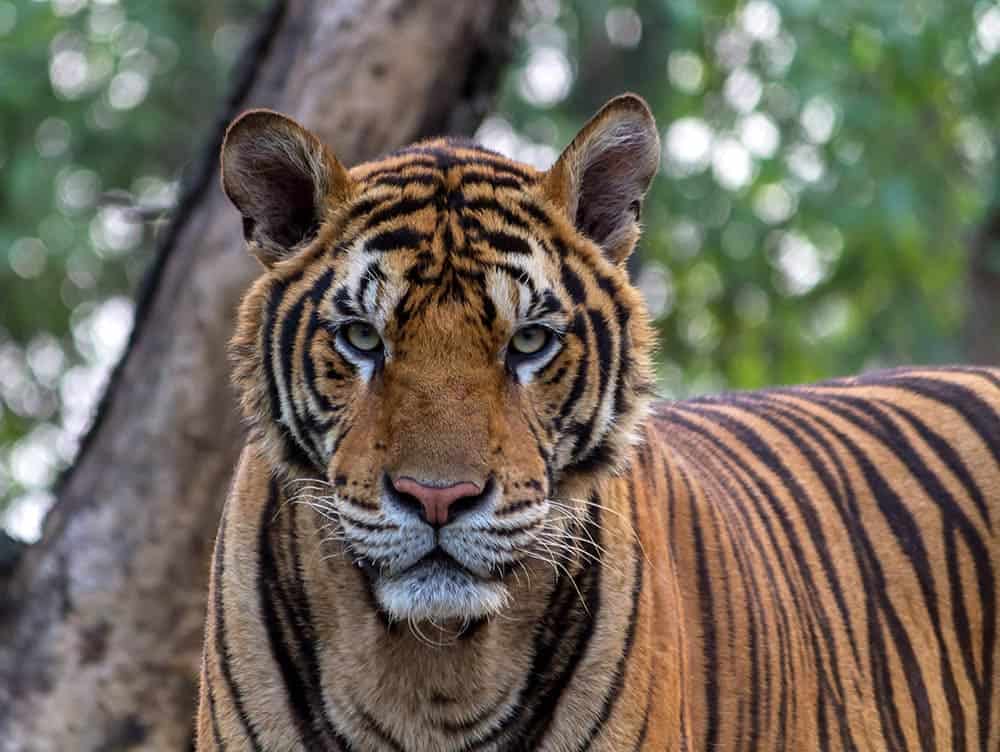
| Latin name: | Panthera tigris |
Tigers are the largest living cat species. Their look is iconic—dark vertical stripes on orange fur with a white underside. Tigers are apex predators that prey mainly on large prey, including deer and wild boar. Tigers are territorial and solitary and require a large area to hunt in and raise cubs. A tiger cub stays with their mother for about 2 years, then leaves it to establish their own territory. Tiger populations once ranged widely, but they’ve lost almost all of their habitat in the 20th century. There’s still a fragmented range of tigers roaming free, ranging from Siberian temperate forests to India and Sumatra, but there’s no doubt that this big Indian wild cat is in real danger of extinction.
15. Asiatic Lion
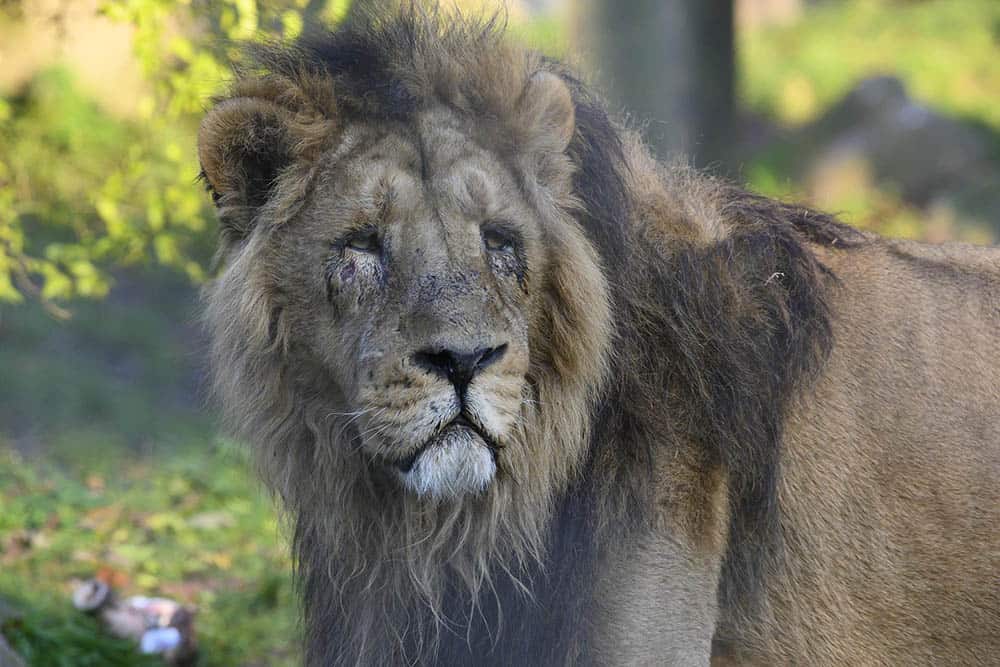
| Latin name: | Panthera leo ssp. persica |
India is the only place in the world where the Asiatic Lion lives in the wild. Gir National Park and the surrounding areas in the Indian state of Gujarat have been its only habitat since the turn of the 20th century. In the past, it inhabited much of the Middle East and northern India. Although it is endangered, thankfully the Asiatic Lion population is on the rise since 2010. Colors of Asiatic Lion fur range from reddish-tan, to flecked with black, to buff-colored grays. Asiatic Lions have less developed manes than African lions.
Usually, male Asiatic Lions form loose prides of up to three males. Typically, females associate with up to 12 other females, forming a stronger pride that shares prey. Male and female lions usually associate only during mating, and rarely live or feed together.

Conclusion
There are a variety of wild cats found in India. While some are more common than others, each one is unique and plays an important role in the ecosystem. It is essential to learn about these animals and their behavior so that we can appreciate and protect them.
Featured Image Credit: Pfuderi, Pixabay
